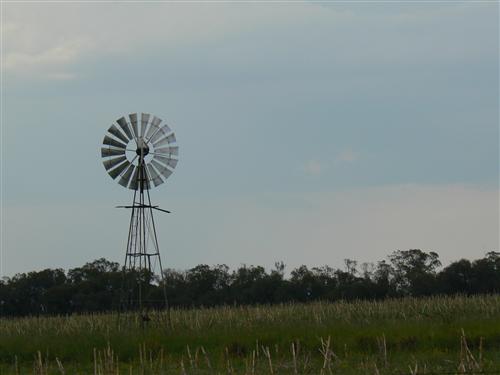The following sections describe small-scale water supply and groundwater within the Orange-Senqu River basin and its respective Water Management Areas (WMAs) in South Africa.
Vaal River WMA
The total groundwater use within the Vaal River basin (South Africa) is estimated at 215 Mm3/a (1995). The Lower Vaal WMA uses 45% of the total and the Middle Vaal WMA uses almost 33% of the total groundwater. The sectors responsible for the greatest demand are the rural domestic and agricultural (livestock) sectors (DWAF 2003c-e).
In the Orange WMAs, total groundwater use is estimated at 115 Mm3/a (1995). The bulk of the groundwater use (59%) occurs in the Lower Orange WMA where surface water resources are limited.
Small-scale water supply schemes include (ORASECOM 2007a):
Sand-Vet Scheme
The scheme comprises Erfenis Dam, Allemanskraal Dam and a series of pipelines, canals and pump stations. Water is released from the Erfenis and the Allemanskraal dams into canals to supply the Sand/Vet government water supply scheme downstream.
Sedibeng Water abstracts water from Allemanskraal Dam to supply part of the Virginia requirement via a pipeline. The water is purified at the Virginia Water Purification Works. Water is also transferred to the Upper Orange WMA (Modder River Catchment) by a gravity pipeline, which leads to a storage reservoir in Bradford, where this water is purified and supplied to users.
Vals River System
This system consists of the Serfontein Dam, which is almost completely silted-up. Water is released directly into the Vals River from the dam and is abstracted and pumped into the Kroonstad Municipality dam, called the Bloemhoek Dam, for supply to the urban area of Kroonstad.
Koppies River System
This system consists of the Koppies Dam from where water is released into the river and into a canal distribution system. The town of Koppies abstracts its water from the river downstream of the Koppies Dam, and further downstream water is abstracted from both the canal system and the river. Water is also abstracted from the river to supply Viljoenskroon with potable water; excess water flows into the Vaal River.
Wentzel Dam sub-system
Wentzel Dam is the highest on the Harts River and relies totally on natural flow from the river. The only existing abstraction from the dam is to satisfy the demand of the town of Schweizer Reneke, estimated at about 1 Mm³/a in 2006.

Groundwater supplies a large proportion of available water in the Orange-Senqu River basin.
Source:Kruchem 2008
( click to enlarge )
Upper Orange WMA
The registered volume of groundwater use within the Upper Orange WMA is 98,3 Mm3/a, representing approximately 10% of the water available for sustainable abstraction. Groundwater represents a large potential resource, particularly for local supply in areas that are distant from the main river system. Groundwater is widely used in the area for domestic and agricultural purposes, also playing a major role in the sustainability and economy of the Modder River catchment (DWAF2003a).
Lower Orange WMA
Groundwater is also an important resource in the Lower Orange WMA. In areas distant from the main stem of the Orange River, 60–70% of the available water is supplied from groundwater. Groundwater is also an important water source for rural communities, and is frequently their only source of water (DWAF 2003b).
Kalahari Rural Water Supply Scheme
This small-scale scheme consists of the Kalahari West, Kalahari East and the Karos-Geelkoppan Rural Water Supply Schemes (RWSS).
Kalahari West: This water supply scheme, northwest of Upington, was initiated following several years of serious drought in this part of the catchment. The scheme consists of a 51 L/s pump station located at the Upington municipal reservoir, which conveys water to the main reservoir (2 500 m³ capacity) near Spitskop (ORASECOM 2007a).
Kalahari East: The Kalahari East Rural Water Supply Scheme was constructed in the early 1990s to supply water to farmers in the Kalahari, north of Upington, with water for livestock watering and domestic use. The scheme sources its water from the Vaal-Gamagara pipeline.
Karos-Geelkoppan Rural Water Supply Scheme
This is a very small scheme supplying water to rural communities north of Upington.
